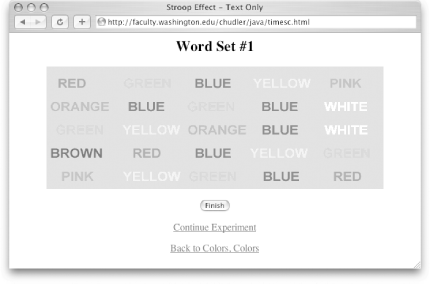Hack #55. Confuse Color Identification with Mixed Signals
When you’re speaking, written words can distract you. If you’re thinking nonlinguistically, they can’t.
The Stroop Effect is a classic of experimental psychology. In fact, it’s more than a classic, it’s an industry. J. Ridley Stroop first did his famous experiment in 1935, and it’s been replicated thousands of times since then. The task is this: you are shown some words and asked to name the ink color the words appear in. Unfortunately, the words themselves can be the names of colors. You are slower, and make more errors, when trying to name the ink color of a word that spells the name of a different color. This, in a nutshell, is the Stroop Effect. You can read the original paper online at http://psychclassics.yorku.ca/Stroop .
In Action
To try out the Stroop Effect yourself, use the interactive experiment available at http://faculty.washington.edu/chudler/java/ready.html 1 (you don’t need Java in your web browser to give this a go).
Start the experiment by clicking the “Go to the first test” link; the first page will look like Figure 5-1, only (obviously) in color.

Figure 5-1. In the Stroop experiment, the color of the ink isn’t necessarily the same as the color the word declares
As fast as you’re able, read out loud the color of each word—not what it spells, but the actual color in which it appears. Then click the Finish button ...
Get Mind Hacks now with the O’Reilly learning platform.
O’Reilly members experience books, live events, courses curated by job role, and more from O’Reilly and nearly 200 top publishers.

